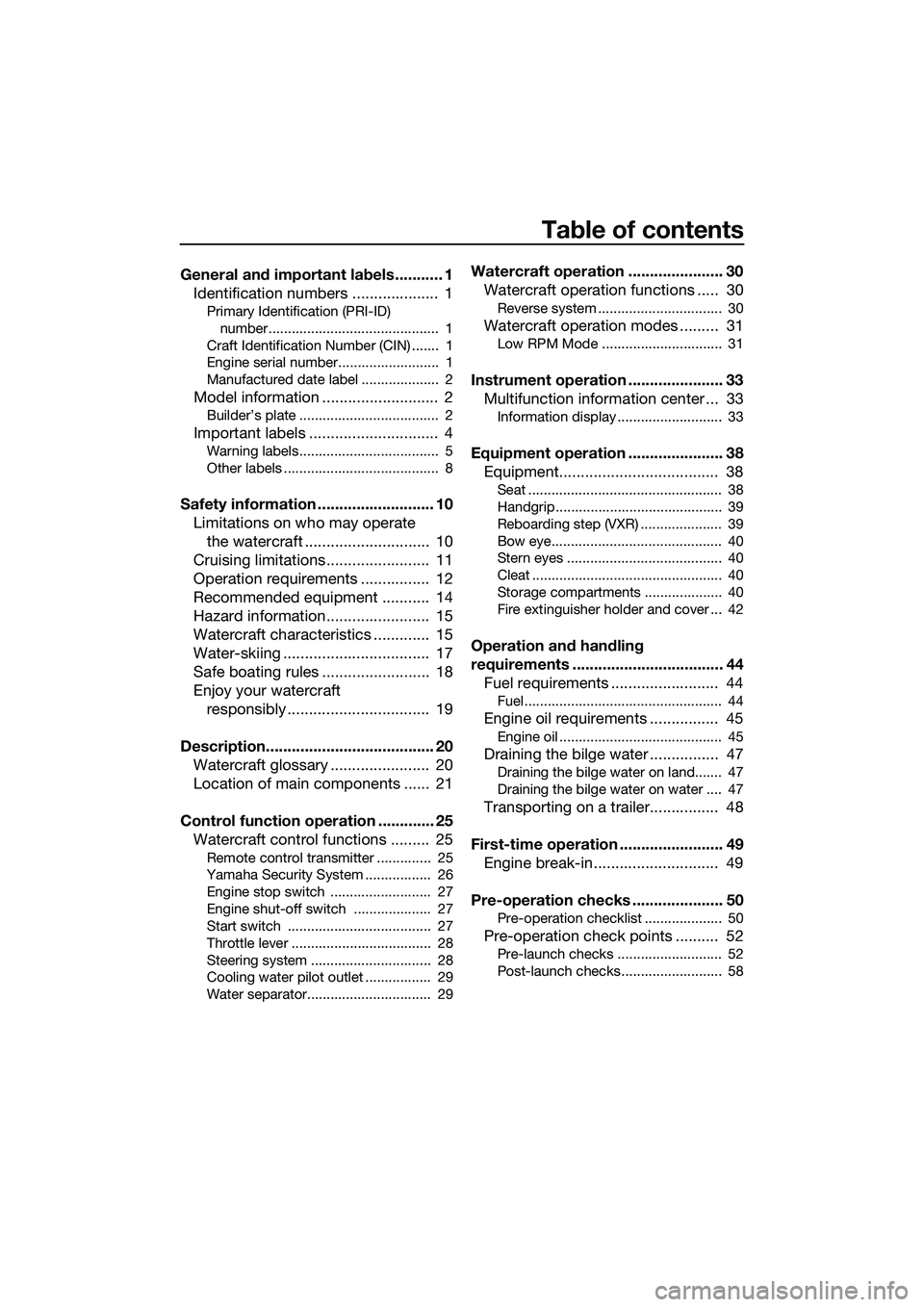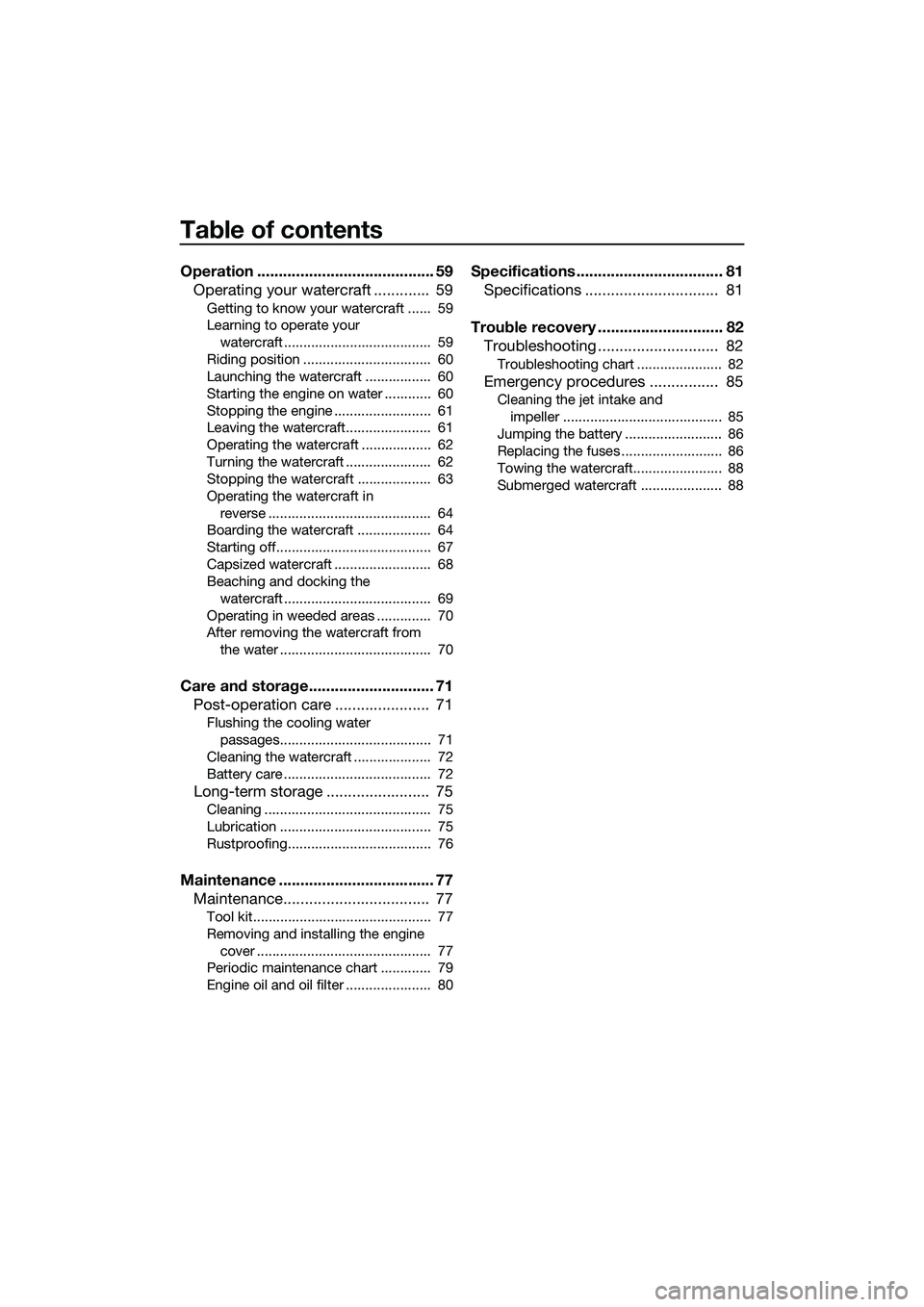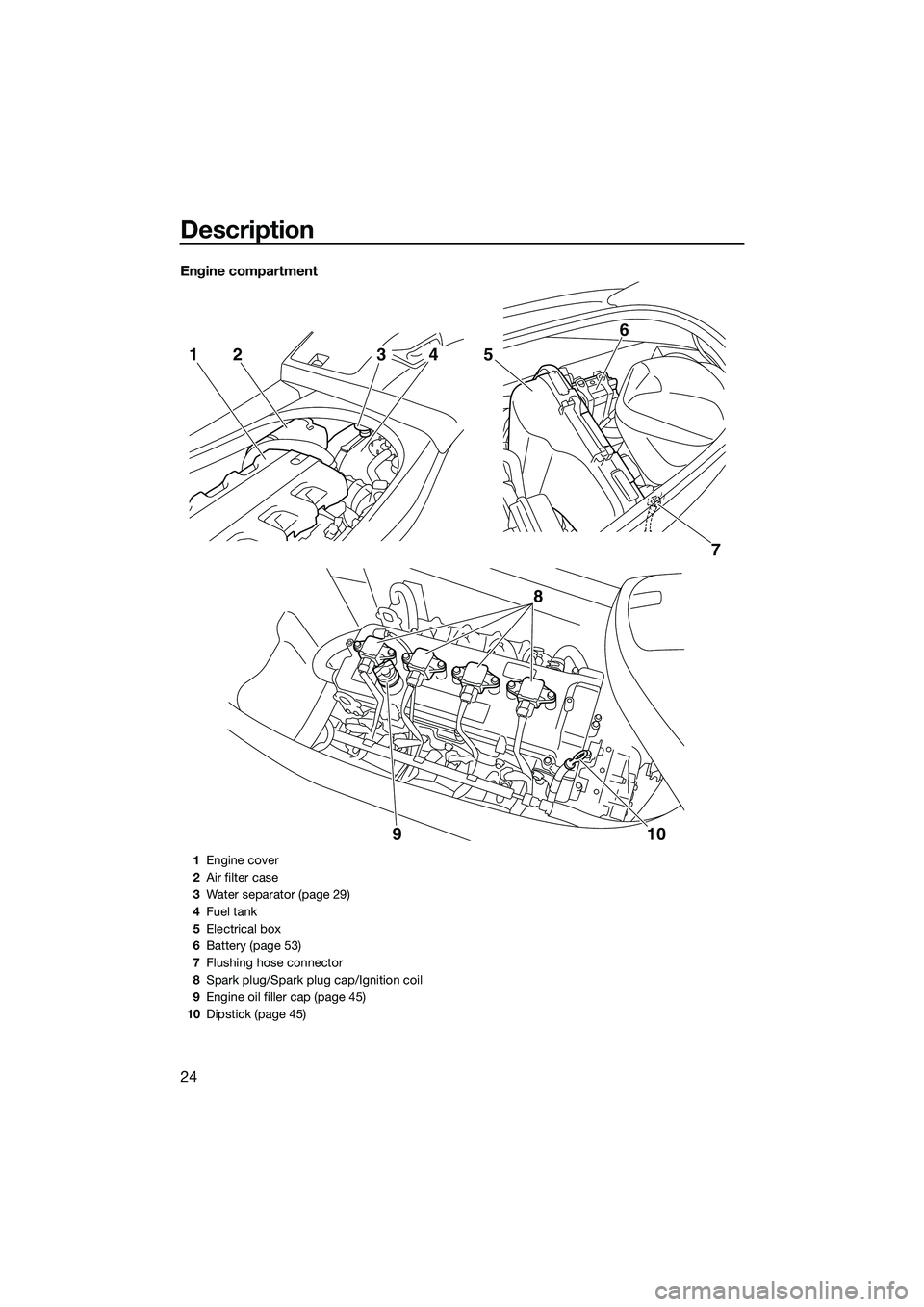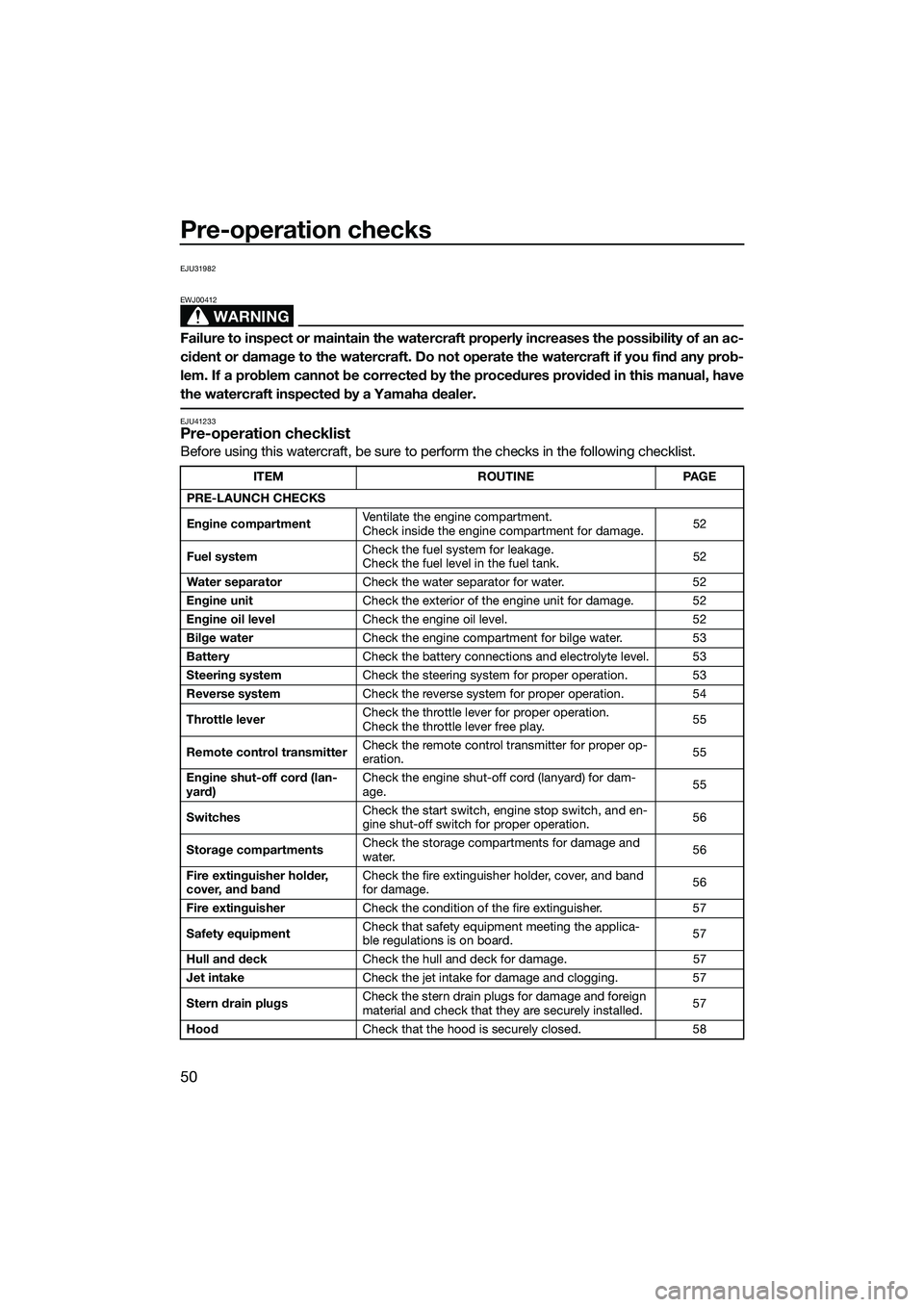engine oil YAMAHA VXR 2014 Owners Manual
[x] Cancel search | Manufacturer: YAMAHA, Model Year: 2014, Model line: VXR, Model: YAMAHA VXR 2014Pages: 98, PDF Size: 3.98 MB
Page 5 of 98

Table of contents
General and important labels ........... 1Identification numbers .................... 1
Primary Identification (PRI-ID)
number............................................ 1
Craft Identification Number (CIN) ....... 1
Engine serial number.......................... 1
Manufactured date label .................... 2
Model information ........................... 2
Builder’s plate .................................... 2
Important labels .............................. 4
Warning labels.................................... 5
Other labels ........................................ 8
Safety information ........................... 10 Limitations on who may operate the watercraft ............................. 10
Cruising limitations ........................ 11
Operation requirements ................ 12
Recommended equipment ........... 14
Hazard information........................ 15
Watercraft characteristics ............. 15
Water-skiing .................................. 17
Safe boating rules ......................... 18
Enjoy your watercraft responsibly ................................. 19
Description....................................... 20 Watercraft glossary ....................... 20
Location of main components ...... 21
Control function operation ............. 25 Watercraft control functions ......... 25
Remote control transmitter .............. 25
Yamaha Security System ................. 26
Engine stop switch .......................... 27
Engine shut-off switch .................... 27
Start switch ..................................... 27
Throttle lever .................................... 28
Steering system ............................... 28
Cooling water pilot outlet ................. 29
Water separator................................ 29
Watercraft operation ...................... 30Watercraft operation functions ..... 30
Reverse system ................................ 30
Watercraft operation modes ......... 31
Low RPM Mode ............................... 31
Instrument operation ...................... 33Multifunction information center ... 33
Information display ........................... 33
Equipment operation ...................... 38Equipment..................................... 38
Seat .................................................. 38
Handgrip........................................... 39
Reboarding step (VXR) ..................... 39
Bow eye............................................ 40
Stern eyes ........................................ 40
Cleat ................................................. 40
Storage compartments .................... 40
Fire extinguisher holder and cover ... 42
Operation and handling
requirements ................................... 44Fuel requirements ......................... 44
Fuel................................................... 44
Engine oil requirements ................ 45
Engine oil .......................................... 45
Draining the bilge water ................ 47
Draining the bilge water on land....... 47
Draining the bilge water on water .... 47
Transporting on a trailer................ 48
First-time operation ........................ 49 Engine break-in............................. 49
Pre-operation checks ..................... 50
Pre-operation checklist .................... 50
Pre-operation check points .......... 52
Pre-launch checks ........................... 52
Post-launch checks.......................... 58
UF2M73E0.book Page 1 Friday, August 2, 2013 11:28 AM
Page 6 of 98

Table of contents
Operation ......................................... 59Operating your watercraft ............. 59
Getting to know your watercraft ...... 59
Learning to operate your
watercraft ...................................... 59
Riding position ................................. 60
Launching the watercraft ................. 60
Starting the engine on water ............ 60
Stopping the engine ......................... 61
Leaving the watercraft...................... 61
Operating the watercraft .................. 62
Turning the watercraft ...................... 62
Stopping the watercraft ................... 63
Operating the watercraft in reverse .......................................... 64
Boarding the watercraft ................... 64
Starting off........................................ 67
Capsized watercraft ......................... 68
Beaching and docking the
watercraft ...................................... 69
Operating in weeded areas .............. 70
After removing the watercraft from the water ....................................... 70
Care and storage............................. 71Post-operation care ...................... 71
Flushing the cooling water
passages....................................... 71
Cleaning the watercraft .................... 72
Battery care ...................................... 72
Long-term storage ........................ 75
Cleaning ........................................... 75
Lubrication ....................................... 75
Rustproofing..................................... 76
Maintenance .................................... 77 Maintenance.................................. 77
Tool kit.............................................. 77
Removing and installing the engine
cover ............................................. 77
Periodic maintenance chart ............. 79
Engine oil and oil filter ...................... 80
Specifications .................................. 81 Specifications ............................... 81
Trouble recovery ............................. 82 Troubleshooting ............................ 82
Troubleshooting chart ...................... 82
Emergency procedures ................ 85
Cleaning the jet intake and
impeller ......................................... 85
Jumping the battery ......................... 86
Replacing the fuses .......................... 86
Towing the watercraft....................... 88
Submerged watercraft ..................... 88
UF2M73E0.book Page 2 Friday, August 2, 2013 11:28 AM
Page 25 of 98

Safety information
19
EJU30992
Enjoy your watercraft responsibly
You share the areas you enjoy when riding
your watercraft with others and with nature.
So your enjoyment includes a responsibility
to treat these other people, and the lands,
waters, and wildlife with respect and courte-
sy.
Whenever and wherever you ride, think of
yourself as the guest of those around you.
Remember, for example, that the sound of
your watercraft may be music to you, but it
could be just noise to others. And the exciting
splash of your wake can make waves others
won’t enjoy.
Avoid riding close to shoreline homes and
waterfowl nesting areas or other wildlife ar-
eas, and keep a respectful distance from fish-
ermen, other boats, swimmers, and
populated beaches. When travel in areas like
these is unavoidable, ride slowly and obey all
laws.
Proper maintenance is necessary to ensure
that the exhaust emission and sound levels of
your watercraft will continue to be within reg-
ulated limits. You have the responsibility to
make sure that the recommended mainte-
nance in this owner’s/operator’s manual is
carried out.
Remember, pollution can be harmful to the
environment. Do not refuel or add oil where a
spill could cause damage to nature. Remove
your watercraft from the water and move it
away from the shoreline before refueling. Dis-
pose of water and any fuel and oil residue in
the engine compartment according to local
regulations. And keep your surroundings
pleasant for the people and wildlife that share
the waterways: don’t litter. When you ride responsibly, with respect and
courtesy for others, you help ensure that our
waterways stay open for the enjoyment of a
variety of recreational opportunities.
UF2M73E0.book Page 19 Friday, August 2, 2013 11:28 AM
Page 30 of 98

Description
24
Engine compartment
7
5
6
8
10
9
2143
1 Engine cover
2 Air filter case
3 Water separator (page 29)
4 Fuel tank
5 Electrical box
6 Battery (page 53)
7 Flushing hose connector
8 Spark plug/Spark plug cap/Ignition coil
9 Engine oil filler cap (page 45)
10 Dipstick (page 45)
UF2M73E0.book Page 24 Friday, August 2, 2013 11:28 AM
Page 39 of 98

Instrument operation
33
EJU41851
Multifunction information center
The multifunction information center displays
various watercraft information.
Multifunction information center initial op-
eration
When the multifunction information center is
activated, all of the display segments and the
“SECURITY” indicator light come on. After 2
seconds, the warning indicators in the infor-
mation display go off, and then the center
starts to operate normally.
TIP:
The “SECURITY” indicator light will go off
when the engine is started.
Multifunction information center standby
state
If the multifunction information center does
not receive any operation input within 25 sec-
onds after the engine stops, the center will
turn off and enter a standby state. When the
engine is started again, the displays return to
their state before the center turned off, and
then the center starts to operate normally.
EJU35025Information display
The information display shows watercraft op-
erating conditions.
EJU31504Speedometer
The speedometer shows the watercraft
speed against water.
By switching the display units, the speed can
be shown in kilometers per hour “km/h” or
miles per hour “mph”.
TIP:
“mph” is selected as the display unit at the
Yamaha factory.
1 “SECURITY” indicator light
2 Select button
3 Information display
4 “L-MODE” indicator light
5 “WARNING” indicator light
21345
1Tachometer
2 Speedometer
3 Hour meter/voltmeter
4 Fuel level meter
5 Check engine warning indicator
6 Engine overheat warning indicator
7 Oil pressure warning indicator
8 Fuel level warning indicator
1 Speedometer
1234
8765
1
UF2M73E0.book Page 33 Friday, August 2, 2013 11:28 AM
Page 42 of 98

Instrument operation
36
TIP:
Push the select button on the multifunction
information center to stop the buzzer.
EJU31627Oil pressure warning
If the oil pressure drops significantly, the oil
pressure warning indicator and the “WARN-
ING” indicator light blink, and the buzzer
sounds intermittently. At the same time, the
maximum engine speed is limited.
If the oil pressure warning is activated, imme-
diately reduce the engine speed, return to
shore, and then check the engine oil level.
(See page 45 for information on checking the
engine oil level.) If the oil level is sufficient,
have a Yamaha dealer check the watercraft.
TIP:
Push the select button on the multifunction
information center to stop the buzzer.
EJU3160AEngine overheat warning
If the engine temperature rises significantly,
the engine overheat warning indicator and
the “WARNING” indicator light blink, and the
buzzer sounds intermittently. Then, the en-
gine overheat warning indicator and the
“WARNING” indicator light stop blinking and
remain on, and the buzzer sounds continu-ously. At the same ti
me, the maximum engine
speed is limited.
If the engine overheat warning is activated,
immediately reduce the engine speed, return
to shore, and then make sure that water is
being discharged from the cooling water pilot
outlet while the engine is running. If there is
no discharge of water, stop the engine, and
then check the jet intake for clogging. (See
page 85 for information on the jet intake.)
NOTICE: If you cannot locate and correct
the cause of the overheating, consult a
Yamaha dealer. Continuing to operate at higher speeds could result in severe en-
gine damage.
[ECJ00042]
TIP:
Push the select button on the multifunction
information center to stop the buzzer.
UF2M73E0.book Page 36 Friday, August 2, 2013 11:28 AM
Page 51 of 98

Operation and handling requirements
45
(6) Stop filling when the fuel level reachesapproximately 50 mm (2 in) from the top
of the fuel tank. Do not overfill the fuel
tank. Because fuel expands when it
heats up, heat from the engine or the sun
can cause fuel to spill out of the fuel tank.
Do not leave the watercraft with a full
tank in direct sunlight.
(7) Wipe up any spilled fuel immediately with a dry cloth.
(8) Securely install the fuel filler cap by tight- ening it until it clicks.
(9) Securely install the seat in its original po- sition.
EJU40291
Engine oil requirementsEJU41871Engine oil
NOTICE
ECJ00282
Use only 4-stroke engine oil. Usage of 2-
stroke engine oil could result in severe en-
gine damage.
Checking the engine oil level
WARNING
EWJ00341
Engine oil is extremely hot immediately af-
ter the engine is turned off. Coming in con-
tact with or getting any engine oil on your
clothes could result in burns.
NOTICE
ECJ01002
Make sure that debris and water do not
enter the oil filler hole. Debris and water in
the engine oil can cause serious engine
damage.
To check the engine oil level:
(1) Place the watercraft in a precisely levelposition on land with the engine
stopped. If the engine was running, allow
the engine oil to settle by waiting 5 minu-
tes or more before checking the oil level.
(2) Remove the seat. (See page 38 for seat removal and installation procedures.)
Fuel tank capacity:
70 L (18.5 US gal, 15.4 Imp.gal)
1Approximately 50 mm (2 in) from top of the
fuel tank
1
Recommended engine oil type:
SAE 10W-30, 10W-40, 20W-40,
20W-50
Recommended engine oil grade: API SE,SF,SG,SH,SJ,SL
UF2M73E0.book Page 45 Friday, August 2, 2013 11:28 AM
Page 52 of 98

Operation and handling requirements
46
(3) Remove the dipstick and wipe it clean.
(4) Insert the dipstick back into the dipsticktube completely. Remove the dipstick
again and make sure that the engine oil
level is between the minimum and maxi-
mum level marks.
(5) If the engine oil level is significantly above the maximum level mark, consult
a Yamaha dealer. If the engine oil level is
below the minimum level mark, add en-
gine oil. (6) Loosen the engine oil filler cap and re-
move it.
(7) Slowly add engine oil.
TIP:
The difference between the minimum and
maximum level marks on the dipstick is equal
to approximately 1 L (1.06 US qt, 0.88 Imp.qt)
of engine oil.
(8) Wait approximately 5 minutes to allow the engine oil to settle, and then check
the engine oil level again.
(9) Repeat steps 3–8 until the engine oil is at the proper level.
(10) Securely install the engine oil filler cap by tightening it until it stops.
(11) Securely install the seat in its original po- sition.
1Dipstick
1 Maximum level mark
2 Minimum level mark
1
2
1
1Engine oil filler cap
1
UF2M73E0.book Page 46 Friday, August 2, 2013 11:28 AM
Page 55 of 98

First-time operation
49
EJU36666
Engine break-in
NOTICE
ECJ00432
Failure to perform the engine break-in
could result in reduced engine life or even
severe engine damage.
The engine break-in is essential to allow the
various components of the engine to wear
and polish themselves to the correct operat-
ing clearances. This ensures proper perfor-
mance and promotes longer component life.
To perform the engine break-in:
(1) Check the engine oil level. (See page 45for information on checking the engine
oil level.)
(2) Launch the watercraft and start the en- gine. (See page 60 for information on
starting the engine.)
(3) For the first 5 minutes, operate with the engine speed at 2000 r/min.
(4) For the next 30 minutes, operate with the engine speed below 5000 r/min.
(5) For the next 1 hour, operate with the en- gine speed below 6000 r/min.
After the engine break-in is complete, the wa-
tercraft can be operated normally.
UF2M73E0.book Page 49 Friday, August 2, 2013 11:28 AM
Page 56 of 98

Pre-operation checks
50
EJU31982
WARNING
EWJ00412
Failure to inspect or maintain the watercraft properly increases the possibility of an ac-
cident or damage to the watercraft. Do not operate the watercraft if you find any prob-
lem. If a problem cannot be corrected by the procedures provided in this manual, have
the watercraft inspected by a Yamaha dealer.
EJU41233Pre-operation checklist
Before using this watercraft, be sure to perform the checks in the following checklist.
ITEMROUTINEPAGE
PRE-LAUNCH CHECKS
Engine compartment Ventilate the engine compartment.
Check inside the engine compartment for damage.
52
Fuel system Check the fuel system for leakage.
Check the fuel level in the fuel tank.
52
Water separator Check the water separator for water. 52
Engine unit Check the exterior of the engine unit for damage. 52
Engine oil level Check the engine oil level. 52
Bilge water Check the engine compartment for bilge water. 53
Battery Check the battery connections and electrolyte level. 53
Steering system Check the steering system for proper operation. 53
Reverse system Check the reverse system for proper operation. 54
Throttle lever Check the throttle lever for proper operation.
Check the throttle lever free play.
55
Remote control transmitter Check the remote control transmitter for proper op-
eration.
55
Engine shut-off cord (lan-
yard) Check the engine shut-off cord (lanyard) for dam-
age.
55
Switches Check the start switch, engine stop switch, and en-
gine shut-off switch for proper operation.
56
Storage compartments Check the storage compartments for damage and
water.
56
Fire extinguisher holder,
cover, and band Check the fire extinguisher holder, cover, and band
for damage.
56
Fire extinguisher Check the condition of the fire extinguisher. 57
Safety equipment Check that safety equipment meeting the applica-
ble regulations is on board.
57
Hull and deck Check the hull and deck for damage. 57
Jet intake Check the jet intake for damage and clogging. 57
Stern drain plugs Check the stern drain plugs for damage and foreign
material and check that they are securely installed.
57
Hood Check that the hood is securely closed. 58
UF2M73E0.book Page 50 Friday, August 2, 2013 11:28 AM